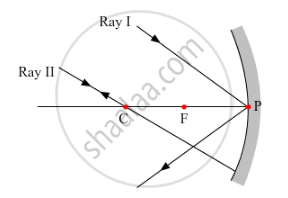Advertisements
Advertisements
Question
To construct ray diagrams, two rays of light are generally so chosen that it is easy to determine their directions after reflection from a mirror. Choose two such rays and state the path/direction of these rays after reflection from a concave mirror. Use these two rays to find the position and nature of the image of an object placed at a distance of 8 cm from a concave mirror of focal length 12 cm.
Solution
The two rays chosen to construct a ray diagram are shown in the ray diagram given below.

(i) Ray I:- When the ray is incident obliquely to the principle axis towards the pole of the concave mirror, the angle at which it reflects back is equal to the angle of incidence.
(ii) Ray II:- When the incident ray passes through the centre of curvature, the light, after reflection from the concave mirror, reflects back along the same path.

The image formed is virtual, erect and magnified. It is formed behind the mirror.
APPEARS IN
RELATED QUESTIONS
"A concave mirror of focal length 15 cm can form a magnified, erect as well as inverted image of an object placed in front of it." Justify this statement stating the position of the object with respect to the pole of the mirror in both the cases for obtaining the images.
A student wants to project the image of a candle flame on the walls of the school laboratory by using a mirror.
(a) Which type of mirror should he use and why?
(b) At what distance, in terms of focal length 'f' of the mirror, should he place the candle flame to get the magnified image on the wall?
(c) Draw a ray diagram to show the formation of the image in this case.
(d) Can he use this mirror to project a diminished image of the candle flame on the same wall? State 'how' if your answer is 'yes' and 'why not' if your answer is 'no.'
An object 4 cm in height, is placed at 15 cm in front of a concave mirror of focal length 10 cm. At what distance from the mirror should a screen be placed to obtain a sharp image of the object. Calculate the height of the image.
A concave mirror has a focal length of 25 cm. At which of the following distance should a person hold his face from this concave mirror so that it may act as a shaving mirror?
(a) 45 cm
(b) 20 cm
(c) 25 cm
(d) 30 cm
Give reason for your choice.
If a concave mirror has a focal length of 10 cm, find the two positions where an object can be placed to give, in each case, an image twice the height of the object.
Which of the following are concave mirrors and which convex mirrors?
The mirror used by a dentist to examine the teeth of a person is:
(d) any one of the above
(a) convex
(b) concave
(c) plane
(d) any one of the above
State two uses of a concave mirror.
The mirror used by the ophthalmologist to examine the eye is _______.
The concave reflecting surface of a torch got rusted. What effect would this have on the beam of light from the torch?
